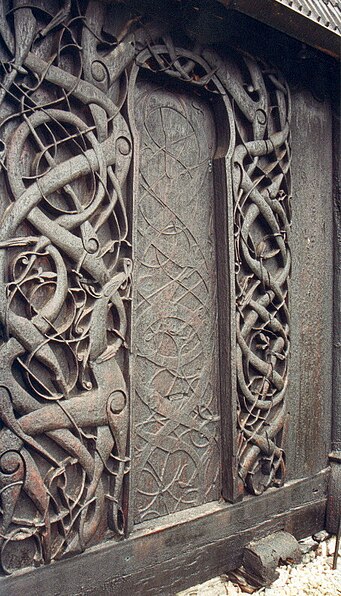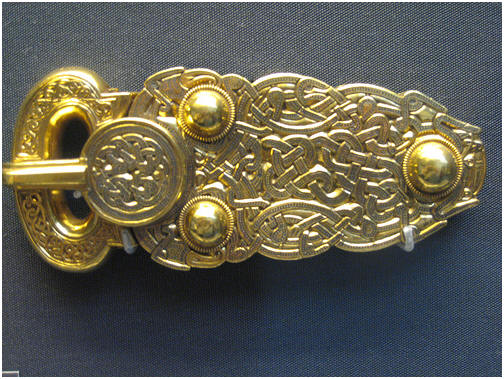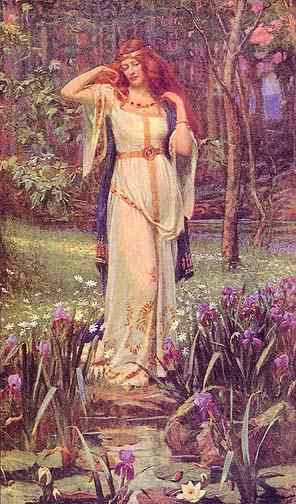So yes, Gandalf was a real person
Actually there were several Gandalfs, but one in particular who is relevant to our Elves.
Ãlfheimr - Wikipedia, the free encyclopedia
I wonder if it is a coincidence Tolkein named his hero after this guy from where the Elves historically lived?

I almost felt like I was walking in his footsteps while researching this article
From the wiki:
The
Ynglinga saga,
Saga of Halfdan the Black, and
Saga of Harald Fairhair, all included in the
Heimskringla, tell of kings of Álfheim at the end of the legendary period:
- Álf: His daughter Álfhild (Álfhildr) married King Gudröd the Hunter of Raumaríki and Westfold who brought with her half of the territory of Vingulmork as her dowry. She bore to Gudröd a son named Óláf (Óláfr) who was afterwards named Geirstada-Álf (Geirstaða-Álfr) and was the elder half-brother of Halfdan the Black.
- Álfgeir: He was son of Álf. He regained Vingulmork and placed his son Gandálf (Gandálfr) over it as king.
- Gandálf: He was son of Álfgeir. Since this Gandálf was an older contemporary of Harald Fairhair and since the historical Viking leaders identified as sons of Ragnar Lodbrok in some traditions were also contemparies of Harald Fairhair, it is not impossible that Álfhild, the supposed mother of Ragnar Lodbrok, was the daughter of this Gandálf as the Hversu Noregr byggdist states. What is told in the Heimskringla is that after many indecisive battles between Gandálf and Halfdan the Black, Vingulmork was divided between them, Halfdan regaining the portion which had been the dowry of his grandfather's first wife Álfhild. Two sons of Gandálf named Hýsing (Hýsingr) and Helsing (Helsingr) later led a force against Halfdan but fell in battle and a third son named Haki fled into Álfheim. When Halfdan's son Harald Fairhair succeeded his father, Gandálf and his son Haki were both part of an alliance of kings who attacked Harald. Haki was slain but Gandálf escaped. There was further war between Gandálf and Harald. At last Gandálf fell in battle and Harald seized all of Gandálf's land up to the Raum Elf river, at that time not taking Álfheim itself.
See also
Gandalf Alfgeirsson - Wikipedia, the free encyclopedia
So How's that for a shocker?
So was Gandalf a big sweaty flea-infested Viking ?
This news could be a bit of a downer. After all, we have come to think of Gandalf as the loveable character from Tolkein, and now from the famous films. It seems a bit jarring to think of him as some … some …
Viking!

[ame="http://www.youtube.com/watch?v=YCxUBOsbl7c"]http://www.youtube.com/watch?v=zVUf2-ZG-l4[/ame]
Actually, the modern conception of a Viking comes primarily from a combination of Victorian fantasy, 19th Century German nationalism and WW II era Nazi propaganda.
The image is so distorted I think in some ways were Tolkeins Elves more like the real Vikings than our modern image. For example, they seem to share the
Elf aesthetic in certain respects.
The Norse / Elf Aesthetic
Consider the famous Urnes Stave Church, a Unesco World Heritage site.
Urnes stave church - Wikipedia, the free encyclopedia
Or this elegant helmet from the Vedndel period, during the time of Alf the Old

(Modern Reproduction of Vendel helm
Or these other small Vendel Artefacts


Viking Rune Stone
Or these little Viking-era artefacts
The broaches and the face on the left are historical antiques in original condition.
The Elf: So Fresh, So clean
Viking - Wikipedia, the free encyclopedia
One thing we know about Elves, they don’t walk around dirty and sloppy all the time like hippies. So what about our historical Gandalf, was he sweaty and flea infested? Actually, he probably didn’t have fleas. Like the Celts and many other European "Barbarians", (and unlike the monks who wrote about them) Vikings were known to be actually quite hygienic. Combs, ear-spoons, razors and similar articles of toiletry are common finds in Viking-era grave sites. In fact the cleanliness of the pagan Vikings was a source of irritation to civilized Christians, according to at least one source:
“…the Danes, thanks to their habit of combing their hair every day, of bathing every Saturday and regularly changing their clothes, are able to undermine the virtue of married women and even seduce the daughters of nobles to be their mistresses.“
-English cleric John of Wallingford, prior of St. Fridswides,
1002 AD
The Norse of this era generally washed their faces and hands every day and bathed as often as possible, normally every few days, at least once a week. Nearly every Norse village or farmstead no matter how small had its bath-house and / or sauna. They combed and washed their hair and beards regularly and washed both their bodies and their garments with lye soap, a habit they apparently inherited from the Celts who seem to have invented it. All this attention to personal hygiene led them to suffer somewhat less from two of the common nuisances of the day: lice and fleas, and all extra disease risk that went with them. (A good reason to stay fresh and clean)
Norse / Elf culture ?
Similarly, while today our biker-like Vikings are often (rather strangely) exclusively associated with an authoritarian image of Odin as All-Father, in reality the Elves in particular were closely associated with Frey, one of the Vanir…
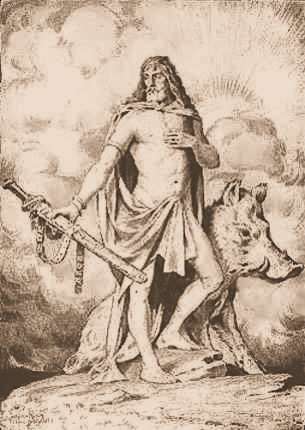
Common modern depiction of Frey, with the Boar-cult he and his sister were often associated with
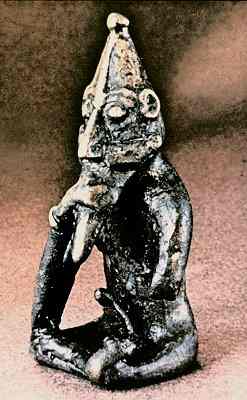
Famous artifact depicting Frey in his characteristic perpetual state of manhood.
…which was apparently an earlier cult than the more famous Aesir. In the Poetic Edda of Snorri Sturlson the Aesir and the Vanir fight a war, which ends in a truce involving the exchange of hostages (some of whom were killed by the Vanir when they believe they were betrayed) This apparently reflected an uneasy truce between the two tribal sects and corresponding political factions, which has been largely forgotten in our modern simplification of the cartoon Viking. For example a lot of people today forgot that the Vanir Goddess Freyja, who was extremely popular and remained so long after official conversion to Christianity, was able to claim fully half of the warriors who died in battle- Half of Norse warriors who died in battle went to Odin’s hall Valhalla which we know so well, but few people today know that the other half went to
Sessrúmnir, Freyja’s party palace (known to be a favorite hang out of Elves, according to the Sagas).
Odin: the creepy, devious, overbearing and perpetually angry All-Father. Into betrayal, hangings and gibbets, friends with two corpse-eating crows.
Freyja, literally a sex goddess, into lust, magic, dancing, poetry, and drinking mead, hangs around with valkyries and elves. I know where I'd rather go to spend eternity.
By contrast, we know from the Sagas that Odin in particular was actually not a popular God during the pagan Viking times except with would-be Kings and Berzerkers. There are few if any shrines to him and very few artifacts associated with his worship remain (unlike the hundreds of Thors hammer pendants which were found in profusion all over Scandinavia) He seems to have risen to higher prominence as an underground anti-hero ironically after conversion to Christianity.
Vikings were also far more chaotic and elf-like in their politics as well. Political power in Viking Scandinavia was in what was called a
http://en.wikipedia.org/wiki/Thing_(assembly) Thing, a combination county faire, legislature, high court, tribal assembly and general election. Gradually toward the end of the Viking age the Thing was overshadowed by new Monarchies, though in Iceland, where they tried to preserve the old-school traditions a bit longer, this became the foundation of one of Europes oldest ever Republics, the
All-Thing, founded in 930 AD.
And unlike in Rome or Greece, women were allowed to attend !
Sidebar said:
:
One famous anecdote captures the Norse attitude toward authority quite well. During negotiations before the treaty of St Claire Sur Epte in 911 AD, in which Rolf the Ganger (Rolf the Walker, so named because he was too big to ride a horse) and his Vikingeleg (Viking band) were granted the City of Rouen and part of the district of Nuestria, which later became the powerful Duchy of Normandy.
Legend has it that when this treaty was nearly completed, Rollo was informed of the standard practice of the requirement of kissing the kings foot. At first refusing in disbelief, after being explained that the act was considered a vital gesture which could not be foregone, he finally ordered a henchman to perform the act. The henchman approached the King, but rather than stoop to kiss the royal foot, grabbed the Charles by his ankle and raised it so high that he fell off his throne.
Sidebar said:
Bohuslän like other parts of Scandinavia, was broken up into small political units called 's hundreds, which originally derived from the older concept of
http://en.wikipedia.org/wiki/Hundred_(country_subdivision)#Other_terms ] wapentake, where all able bodied fighting members of the tribe gathered to vote (and you couldn’t vote if you didn’t show up armed). This tradition was widespread in ancient Europe continued in certain areas such as some parts of Switzerland (including the Canton of Appenzell) to this very day. The Hundreds of Bohuslän were:
So our Gandalf may not have been quite the sweaty authoritarian biker we envision.
Norse Elves: Not as chaste as Tolkeins
Tolkein was an extremely devout Catholic and his chaste and calm elves were somewhat Angelic in character. Not so the Scandinavian Alfar, who while they did have a bit more dignity than the average human Viking, were decidedly pagan and generally a much more raw and lusty type of Elf than Tolkeins Noldorin. The Sagas are full of stories of the Alfar carousing, sleeping around, drinking to excess and getting in fights. Crossing an Elf, as with any fairies whether they be in Ireland, Germany, Russia or Finland, was a dangerous habit because these people would hold a grudge and were very resourceful. Please one on the other hand, whether with a nice roll in the hay, a clever poem, a some beer and a nice meal or a valuable gift, and they will often return the favor in a very “old school” way.
The latter tradition lives on to this day in Scandinavia as the Álfablót (Elf-Sacrifice):
Ãlfablót - Wikipedia, the free encyclopedia
Skålgropar, a particular kind of
petroglyph found in Scandinavia, were known in older times as
älvkvarnar (elven mills), pointing to their believed usage to provide little treats for the Elves, who would presumably return the favor. This tradition was documented to have continued in Scandinavia until at least the 19th Century. (A recent survey in Iceland revealed 80% of the population believed in Elves)
The locals don’t like to talk about it much, but here are some photos of
älvkvarnaI was able to find after a long search (and some help from some Swedish HEMA fighters I know):
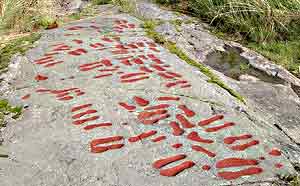

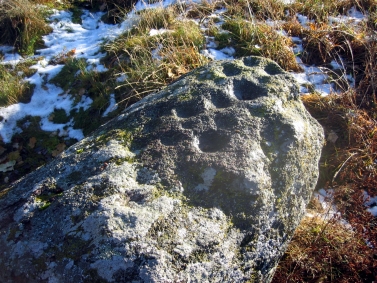
To this day in Scandinavia, according to local folklore Dryad like creatures such as the
Huldra, remain to haunt the woods, (a Huldra being a sexually voracious she-troll said to be both beautiful and elegantly dressed, other than having a foxes tail, to which it is wisest not to bring uncouth attention lest you annoy them. If you are polite and friendly on the other hand, you may find them friendly too…)

Modern conception of a Huldra,
from the wiki
The real Gandalf: probably not a wizard.
Speaking of Magic, our historical Gandalf was very likely not a Wizard. That isn’t to say he definitely wasn’t.
The reason why it’s unlikely is that Magic in Viking Age Scandinavia on-back was almost exclusively the purview of women. Norse magic is called Seidth or Seidr or Seid, and could as a general rule only be practiced by women. It may have involved female sexual practices. This did not apparently stop Odin from learning it, something Loki mocked him for during a famous confrontation recorded in the Poetic Edda.
Seid - Wikipedia, the free encyclopedia
There are numerous female Wizards depicted in the Icelandic sagas, far too many to mention here, but it's worth noting that Scandinavian sorceresses were not just a thing of mythology. Arguably the single most famous Viking archeological site, and without a doubt the finest Viking ship ever unearthed, was the famous Oseburg ship burial.


Detail of dragon head prow from Oseburg ship
Oseberg ship - Wikipedia, the free encyclopedia
This was a burial of two woman, apparently a high-status sorceress and her servant or companion. The Lady was buried with a wand, and marijuana seeds. Norse sorceresses were known by the somewhat evocative name of a
Völva.
Völva - Wikipedia, the free encyclopedia


Another famous burial of a Volva included an iron wand and an expensive pendant depicting Freyja and her famous necklace, the
Brísingamen (which was made by dwarves Freyja had to sleep with to get them to build it)
It is just possible Gandalf was a Wizard though. There were a few rather manly semi-historical characters who practiced magic, including the infamous Egil Skallagrimson, one of Icelands national heroes and a man who makes several lists of the deadliest people in history. Egils saga records Egil casting several spells, including a curse aimed directly at his principle rival Erik Bloodaxe, King of Norway, and his wife Gunnhild, who was herself a famous witch.
The Norse / Elf Weapon: alternative to Elf-Ninjas?
Finally, our modern fantasy interpretation of Tolkeins Elves, including the films which I liked a great deal, seem to have invented a curious kind of samurai type weaponry for the Elves, I suspect probably since the perception of European (let alone Viking) weapons being too crude and clumsy for such graceful people.
Needless to say, as the author of the Codex Martialis, an avid historical martial artist and owner of a few high quality historically accurate sword replicas myself, this is a pet peeve of mine. Because of course the reality was far different. The Vikings and their Vendel era predecessors had some absolutely first rate swords, at least as sophisticated and effective, not to mention beautiful, as anything in the world at that time (including in Asia)
Vendel sword

(original)
Since the original is 1300 years old, some Modern reproductions can help us grasp what it looked like “back in the day”
 fancy enough for an Elf?
fancy enough for an Elf?
A couple more Viking swords (replicas) from Patrick Barta of Templ, who does some of the most historically precise reproductions from this period available anywhere in the world (well worth it if you have a lot of money and the patience for a fairly long waiting list)


A truly elfin blade, in my opinion.
12th Century Sword, axe and Spear found in Finland (An original: Keep in mind it’s 800 years old which causes a bit of rust)

10th Century sword from a womans Grave, also from Finland

..here is a modern replica of it by Rob Miller of Castle Keep:
Castle Keep, Isle of Skye - Fine Handcrafted Blades
“The central part of their blades, cunningly hollowed out, appears to be grained with tiny snakes, and here such varied shadows play that you would believe the shining metal to be interwoven with many colours.”
-5th century Roman Diplomat and author Cassiodorus, describing pattern welded sword made by the Teutonic Warni tribe.
As you may have noticed from the photos, many weapons from this era were made with a very sophisticated pattern welding technique (often mistaken for "Damascus Steel") which was a way to combine high and low carbon steel to make swords of superlative quality. The Norse called this the “Serpent in the Steel” or the "Dragon in the Steel", and normally you couldn’t see the pattern unless the sword was etched with a mild acid (which was sometimes done with tanic acid, vinegar or urine) but could always be detected when you thrust it into the snow and then blew across the blade to warm it with your breath... the “serpent” pattern would appear for a moment then fade away.
Now if this isn’t sufficiently Magical for Elves in your campaign then you probably prefer WoW to DnD
 http://www.templ.net/pics-weapons/110-viking_sword/110-damask_blade.jpg
http://www.templ.net/pics-weapons/110-viking_sword/110-damask_blade.jpg
Detail (URL only)
TEMPL: Making of weapons - blades
Pattern Welded Swords






